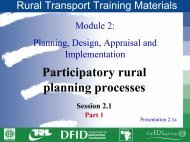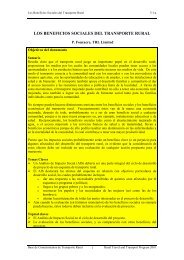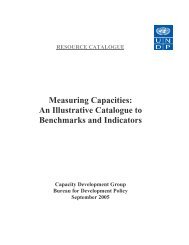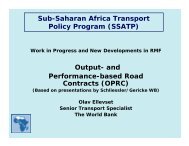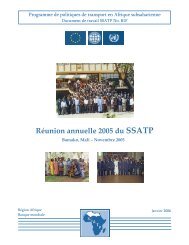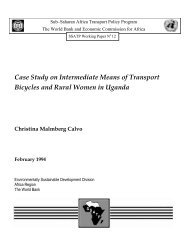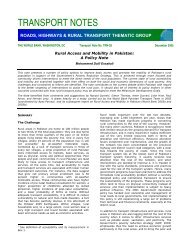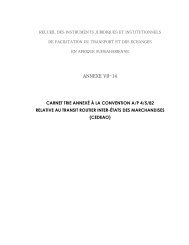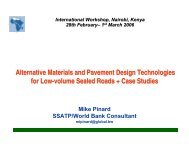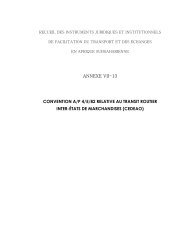RURAL TRANSPORT SURVEY TECHNIQUES - World Bank
RURAL TRANSPORT SURVEY TECHNIQUES - World Bank
RURAL TRANSPORT SURVEY TECHNIQUES - World Bank
Create successful ePaper yourself
Turn your PDF publications into a flip-book with our unique Google optimized e-Paper software.
Rural Transport Survey Techniques5:5:a<strong>RURAL</strong> <strong>TRANSPORT</strong> <strong>SURVEY</strong> <strong>TECHNIQUES</strong>Objectives of the paperAbstractP. Fouracre, TRL LimitedRural transport planning is placing less emphasis on infrastructure development, andmore on the provision of transport services which meet the local community andindividual needs. To understand the nature of these transport needs requires a muchfuller appreciation (than has perhaps been the case in the past) of community life andthe contribution that transport can and does make to sustainable livelihoods. It alsorequires a clear understanding of cross-sectoral linkages and the impacts throughoutthe local economy which result from transport development. This understanding canonly be developed through local knowledge, with the joint participation of theenquirer, the local community and other stakeholders who have an interest in theoutcome of proposals for transport development. Participatory enquiry also supports amuch greater focus on poverty issues, and the role of transport in sustainablelivelihoods.Notwithstanding this need for participatory enquiry, there is still a need for thetraditional surveys that establish the nature of the existing transport framework, andidentify the opportunities for development. These surveys provide an inventory oftransport infrastructure and services, as well as an appraisal of transport productivity.They can help to pinpoint measures (technical, institutional and financial) forimproving efficiency. These surveys may also provide supporting evidence forcommunity perceptions on transport, or exceptionally, may provide somecontradictory arguments that would need to be resolved.Key issues! To highlight the use of participatory surveys for understanding travel needs inrural communities.! To endorse the continuing need for surveys that catalogue the transport system, itsdevelopment and its productivity.! To highlight the complementary nature of different surveys, and the need todeploy resources over a range of survey typesKey topic areas! Surveys which help to define and describe the transport system and opportunitiesfor development! 'Traditional' surveys used to establish the nature of transport demand, and forforecasting travel growth.! Participatory surveys, and their role in developing local transport.Rural Transport Knowledge Base Rural Travel and Transport Program 20011
Rural Transport Survey Techniques5:5:a1 INTRODUCTIONRural transport surveys are typically undertaken in order to identify how well currenttransport functions, the opportunities for transport development and the needs of, ordemand for transport that is expected over the foreseeable future. Variations on thisgeneral scheme include: monitoring the impacts (in its very widest interpretation) oftransport and transport changes; monitoring how transport responds to both internal(e.g. regulatory change) and external (e.g. increased road charges) stimuli; andanalysing changes to the organisational and institutional structures that support thetransport sector. Surveys are required to provide both the quantitative and qualitativedata upon which the appropriate analyses can be developed. There is a range ofsurveys available to the enquirer, and these can be grouped into two main categoriesthat describe the basic purpose of the enquiry, which are:• Supply surveys that describe the nature of the transport system, its scale andproductivity, its bottlenecks and the scope for its development.• Demand surveys that describe the way in which transport is currently used, orwhich describe current user satisfaction or how users would prefer to be suppliedwith transport to meet their needs.These supply and demand-side surveys are applicable to all modes of transport,including freight and passenger carriage, as well as motorised, human and animalpowered vehicles. The supply-side surveys are likely to be quantitative in nature,focussing on the establishment of performance indicators, growth factors, costs, etc.Many surveys yield data that is directly input into analytical models like HDM3(Highway Design and Maintenance Standards) and HDM4 (Highway Developmentand Management). Comparative analyses using these data can be undertaken to goodeffect, both on a national and international basis. Given the right resources, thesequantitative indicators are also relatively easy to monitor over time, and somedatabase models have been designed for storage and analysis of this information (e.g.the Micro Accident Analysis Package, MAAP, and road maintenance managementprograms). Some qualitative information will be gathered to describe institutionalstructures, as well as the quality of transport provision (which may be a veryimportant consideration for some transfers, e.g. perishable goods).Demand-side surveys are also likely to be quantitative in nature, but there will also bea much greater degree of qualitative information gathering that describes user needsand satisfaction. Indicators (e.g. accessibility measures) may assist in quantifyingsome of these qualitative attributes, but they are not absolute measures. Demandattributes and aspirations are also likely to be much more tied to parochial factors, andhence less easy to analyse by comparative techniques.2 SUPPLY SIDE <strong>SURVEY</strong>STable 1 outlines the main surveys that are applicable to the quantification of transportsupply. The surveys cover both roads and transport services, though it will be evidentthat some surveys will provide information across this divide (e.g. it is possible toderive information on travel speeds from both in-vehicle surveys and passengerinterviews). It will also be evident that some surveys provide information that isRural Transport Knowledge Base Rural Travel and Transport Program 20012
Rural Transport Survey Techniques5:5:aequally pertinent to a description of the demand-side: for example, the derivation fromuser interviews of user characteristics, attitudes and perceptions.2.1 Road Surveys2.1.1 InventoriesAn inventory of the road network in the area of study may be needed to confirm therecords of the highway agency. The records for an isolated area may be particularlyvulnerable to error. Furthermore, an important component of the network, which willnot be captured by the highways authority, are the paths and tracks that may providevital communication links at the village level.The detail required of the inventory should be established before its execution, andwill cover the amount of measurement expected (road widths and lengths),identification of structures (bridges, culverts, etc) and other roadside furniture (roadsigns).The inventory may be undertaken in association with the maintenance surveyprogramme. Depending on the level of detail, the inventory can be accomplishedvisually from a vehicle, or may involve frequent stopping to complete measurements,or even 'walking the road'.2.1.2 Traffic countsTraffic counts are conducted to record the level of use of a road, as well as to classifythe vehicles by type, and to estimate vehicle occupancies (i.e. the average numbers ofpassengers carried by each vehicle type). Classification is particularly used tohighlight the amount of heavy goods vehicles (HGVs), and is used in association withaxle-load surveys to indicate both the design requirements and the amount of damagebeing inflicted on the road pavement.Traffic counting can be undertaken manually, or more conveniently by automatictraffic counters. The latter can record and store information for long periods, beforebeing read. Modern counters record information in electronic format that can bedownloaded straight into customised traffic analysis software. (However, many of theautomatic traffic counters currently available are not well suited to use in rural areas.)Automatic counters are also capable of recording vehicle classifications, although theaccuracy is generally poor. Vehicle occupancy counts must be undertaken manually.The main output from a traffic count is a measure of average traffic flow, recorded asthe total traffic passing in both directions over a 24 hour period (the Average DailyTraffic or ADT). For low volume roads the variability in traffic flow from day to daycan be very high, and short counting periods can introduce high errors in estimates.Variability from seasonality (with the possibility of impassability in the rainy season),may be important. Adjustment factors for seasonal variation are usually difficult toestimate with any degree of accuracy.The accuracy of traffic counts is improved as the count duration increases, when thecount is undertaken in more than one period of the year and on roads with higher trafficvolumes. Improved accuracy can also be achieved by using local knowledge todetermine whether there are days within the week or periods during the year when theflow of traffic is particularly high or low. Factors to look for include:• market daysRural Transport Knowledge Base Rural Travel and Transport Program 20013
Rural Transport Survey Techniques5:5:a• religious days• people travelling to and from urban areas for the weekend• wet weather affecting road traffickability and desire to travel• increased traffic flows during harvest seasonsIt is also important to avoid counting on days when there is likely to be exceptionallyhigh or low traffic, counting on these "exceptional days" can have a significant impacton accuracy. Factors to look for include:• national holidays• local holidays• strike days• closed bordersTraffic counts on low volume rural roads should also include pedestrians, bicycles andother non-motorised means of transport (NMT’s). Local knowledge should also be usedto pick appropriate locations for conducting the traffic counts to ensure a true reflectionof the traffic using the road to avoid under or over counting. Factors to look for include:• Avoid counting too close to towns and villages• Be aware of the location of junctions and the impact of these on traffic flows• Pedestrians and NMT’s may use local footpaths and tracks in addition to the road.When counting this type of traffic ensure that the count station is located to captureall traffic• Rural people predominantly travel as the sun is rising and as the sun is setting• When counting in the wet season have knowledge of local diversions on poor roads2.1.3 Travel Speed SurveysMeasurements of travel speeds can be made directly though in-vehicle observation, orindirectly from the responses of shippers, transporters and passengers about thecharacteristics (including times) of their travel. The former (in-vehicle observations)will yield travel times that mostly reflect the performance of the road (i.e. the level ofcongestion and the passability of the road). The latter (user and transporter responses)may include other time components like passenger waiting times, times associatedwith goods loading/unloading, operational 'lost' times). Both measures may beimportant in different contexts of enquiry.2.1.4 Road Maintenance SurveysThese are periodic surveys of road condition, which may either be completed byvisual inspection, or using instrumentation to measure key characteristics (surfaceroughness, rutting, etc.). In visual inspection a rating scale of road condition (perhapscovering several characteristics of the road) is used to assess the status of, or need for,maintenance. Increasingly, data from these surveys is stored in computer-baseddatabases, which are used to analyse the information and help in the management ofroad maintenance programmes.2.1.5 Axle-load SurveysThese are undertaken principally to establish the nature of heavy goods traffic, and inparticular the amount of vehicle over-loading. A significant amount of road damage iscreated by over-loaded heavy goods vehicles.Rural Transport Knowledge Base Rural Travel and Transport Program 20014
Rural Transport Survey Techniques5:5:a2.1.6 Road Safety SurveysPolice records of road accidents are the primary source of information on road safety.However, their records are subject to error and omission, and furthermore may beinadequate for the needs of the safety analyst intent on designing remedial measures.Some progress has been made in the design of improved data capture techniqueslinked to computerised databases (e.g. the TRL Micro Accident Analysis Package -MAAP), which are simple to use and helpful to the policemen in the field. By usinggraphic representation and simple 'tick-boxes', the Accident Report Form has beenmade much more user-friendly and, as a result, a more reliable source documentwhich can pin-point both the location and the nature of an accident.Road safety audits attempt to identify potential road hazards (and the need forremedial measures), based on the experiences of the auditor. Such surveys could beundertaken at the time of completing a road inventory, but require specialistknowledge.2.2 Road User Surveys2.2.1 Operator SurveysOperators of both trucks and public transport can be interviewed to yield informationthat can be wide-ranging, covering: vehicle productivity and costs; labour utilisationand costs; tariffs and fare structures; route structures; operating practices;organisational structures within the industry. Operators are likely to be a useful sourceof information concerning constraints on the provision of services to rural and isolatedareas. They are also likely to have candid views on regulatory policy, as well asproviding an insight on vehicle design and maintenance.2.2.2 Driver SurveysDrivers and operators may be one-and-the-same, but equally drivers may beemployees of the vehicle owner or may hire the vehicle from the owner on a dailybasis. Where they are not one-and-the-same, driver interviews may yield a differentperspective on operating practices. Drivers can also be a source of information onvehicle productivity and costs comparable to that derived from the vehicle operators,particularly in the case where the driver is hiring the vehicle. This source isparticularly useful in the informal or non-corporate sector, where vehicle owners maykeep few records of vehicle utilisation.2.2.3 Farmer SurveysFarmers are a main source of information on farm vehicles, which may also be usedfor carriage of goods and people on the highways. Vehicles may be animal poweredor motorised. The types of information which farmers can yield are similar to those ofoperators and drivers. Farmers are also main users of haulage transport, and hence asource of information on transport services provision.2.2.4 Passenger SurveysPassengers can be interviewed to obtain information about their travel and theirsatisfaction with service provision. They can also be monitored to capture informationon their waiting times, the loading patterns on vehicles, average travel distances, etc.In-vehicle surveys use observers (the number depending on the size of vehicle) whomonitor numbers boarding and alighting at each stopping point along the vehicleRural Transport Knowledge Base Rural Travel and Transport Program 20015
Rural Transport Survey Techniques5:5:ajourney. The same observers can also derive information on vehicle speeds byrecording times of arrival at pre-determined timing points. By staying with onevehicle thoughout the day, an observer can also determine information on the vehiclesutilisation, productivity and revenue earnings.2.2.5 Shipper SurveysGoods consignors (e.g. farmers) are a source of information concerning the quality ofhaulage, tariffs, the availability of choice, etc.Rural Transport Knowledge Base Rural Travel and Transport Program 20016
Rural Transport Survey Techniques5:5:aSector Survey Purpose/Potential Output Indicator/ CommentsRoadsInventoryTo confirm Road Agency networks data. Inventory of local ruralroads km. categorised by different road standards. Other details(road furniture, structures, etc.) may also be captured.Road usersThe Highways Authority records cannot always be relied on foraccuracy. Paths and tracks are unlikely to be recorded at all.Traffic countsTo establish traffic levels hourly, daily and seasonal distributions andcomposition on the local road network. Hence to identify or confirmtraffic congestion.Measured as an estimate of Average Annual Daily Traffic (AADT).There can be extreme variation in daily counts on low-traffickedroads, as well as seasonal variation..Travel speed surveys Average speeds and delays along local routes Direct measurement of transport service on offer, as well as someRoad maintenanceTo establish the state of repair of the local network, and the need forremedial works.indication of the road performance.Maintenance management systems are increasingly being used tokeep track of the state of the road network. For local feeder roads thismay be less practical, because of the isolation, difficulty inmeasurement and hence cost.Axle-load surveysTo establish the degree of vehicle over-loading, and hence thedamaging impact on roads.An important input into pavement design.Safety statistics and audits To establish the location and nature of road safety hazards. Accident rates and trends.Operator surveysTo establish a variety of data: route structures; operating practices;fare structures or freight charges; vehicles in use and theircharacteristics; vehicle utilisation and costs; the nature of regulatoryand institutional issues; prospectsDriver surveysPassenger loading surveysPassenger waiting time surveysPassenger interviewsShipper interviewsIn many instances, similar information to that from the operatorsurveys.To determine the productivity of a passenger vehicle, but this surveycan also be used to measure vehicle speeds and average passengerjourney distance.To measure the level of service (frequency of service and waitingtimes).To measure journey distances and times, fares paid, satisfaction,preferences.To measure journey distances and times for consignments, tariffs,satisfaction, preferences.Table 1: Supply-side SurveysContributes to an assessment of passenger/freight service to the localcommunity.The driver and operator may be one and the same in many cases.Where they are different, the driver may give a very differentperspective to that of the operator.Indicators of vehicle productivity, and possible identification of scopefor improving output.A performance indicator of the transport service on offer.Contributes to measurement of the performance of transport service,as perceived by user.Contributes to measurement of the performance of transport service,as perceived by the user.Rural Transport Knowledge Base 7Rural Travel and Transport Program 2001
Rural Transport Survey Techniques5:5:a3 DEMAND-SIDE <strong>SURVEY</strong>SThe survey techniques used in rural transport projects have become more participatoryin their methodology, and now tend to focus on the household and community level.This is because the increasing focus on poverty analysis has highlighted a failure toinvolve the poor in the development and refinement of public policy, and in theenrichment of their own lives. Participatory enquiries contribute to the developmentof sustainable livelihoods analysis, which seek to establish how individuals,households and communities can enhance their prospects through better access tobasic needs and opportunities. Hence, participatory methods have been adopted inassociation with more conventional qualitative methods.The latter, more traditional methods of enquiry include origin-destination surveys,cordon surveys, household surveys and stated preference surveys. The outputs fromthese are largely quantitative, and may sometimes be directly input into transportplanning models (though this is more a feature of urban transport planning).Table 2 indicates the main survey types, which are described in a little more depthbelow. The participatory instruments are presented last, with some more detail abouttheir background.3.1 'Traditional’ Travel Demand Surveys3.1.1 Origin-destination SurveysOrigin-destination surveys seek to establish the nature of travel patterns in and aroundthe area of enquiry. Typically, on the basis of sampling, an estimate is made of alldaily trips between and within a pre-defined set of zones. The zones are usually basedon existing demographic and political divisions, for which some socio-economic datamay be available. The trip information is usually presented in matrix form, orgraphically with a line (with width proportional to size of trip-making) linking eachpair of zones and representing movements between any pair of zones. Thisinformation can be further refined by presenting, say, public transport trips separatelyfrom private vehicle trips.3.1.2 Cordon and Screen-line SurveysThese surveys yield similar information to an origin-destination survey, though on asmaller scale since they only capture traffic movements across the screen or cordon.As indicated above, they are often used to up-date an earlier origin-destination survey.3.1.3 Stated Preference and Revealed Preference SurveysIn Stated Preference Surveys respondents are given the opportunity to make choicesbetween proposed transport options. Questions are structured in such a way that theanalyst can have some confidence that the respondent is making a logical selection.The technique, which has its origins in market research, can be used to gauge thelikely support and demand for a particular option. The analyst can also establish howthe respondent 'trades' between different attributes of transport options, and inparticular between time and money. Hence, through this technique it is possible toderive a value of time.Rural Transport Knowledge Base 8 Rural Travel and Transport Program 2001
Rural Transport Survey Techniques5:5:aRevealed Preference Surveys seek to establish in retrospect how respondents reactedto changes in transport that have been completed, and to use this information as amodel for future change.3.1.4 Household SurveysThese surveys are used to establish the nature of travel, and the attributes (mainlysocio-economic) of the household that influence their travel. For example, income andvehicle ownership may be strongly associated with more frequent or longer trips. Inthis way Household Surveys are used to develop demand-forecasting models based onthese types of association.Panel Surveys involve the same set of households and individuals being interviewedover time, a means by which the long-term effects of change can be monitored (see,for example, Airey and Cundill, 1998).3.2 Participatory Surveys3.2.1 Village Leadership DiscussionThis provides a means for obtaining base data about the community, and an overviewof its travel patterns, transport constraints and problems. Such a gathering, with astructured discussion, is seen by Barwell (1988) as the first stage in developing adialogue with villagers about their transport problems and improvements.3.2.2 Participatory Poverty AssessmentsParticipatory Poverty Assessments (PPAs) emerged in 1993 when they began to beimplemented in association with the <strong>World</strong> <strong>Bank</strong> Poverty Assessments supported byDFID and SIDA (Swedish International Development Authority) as a means ofseeking a deeper understanding of the causes and consequences of poverty; they seeksolutions in policy and practice which will break the cycle of persistent poverty andlead to its sustained reduction. PPAs seek to understand poverty from the viewpoint ofthe poor themselves, and include their voice in decision-making processes that affectthem. Poverty is not simply an economic condition, it involves other intangible issuessuch as vulnerability, social exclusion, powerlessness and insecurity which traditionalmethods of poverty analysis are unable to capture because they fail to understand howthe rural poor perceive their own status. PPAs enable transport practitioners to learnabout the poor, the assets available to them, and their capacity for recovery.3.2.3 Rapid and Participatory Rural AppraisalParticipatory Rural Appraisal (PRA) and Rapid Rural Appraisal (RRA) came intobeing in the late 1970s, in response to the criticism of the assumptions upon whichearlier development work was based. PRA and RRA emphasise a transfer ofknowledge between researcher and participant, a relationship that has replaced the oneway transfer of knowledge from the north to the south. PRA involves the thoroughanalysis of rural peoples’ situation by the rural people, and allows them to identifysolutions to improve their situation, whereas RRA facilitates the transfer ofknowledge from locals to outsiders in a cost-effective way. Refer to Paper 5:6:a onParticipatory Rural Appraisal for further information.Rural Transport Knowledge Base 9 Rural Travel and Transport Program 2001
Rural Transport Survey Techniques5:5:aSurvey types Surveys Purpose Indicators/Comments'Traditional' Transport SurveysParticipatory SurveysOrigin-destination surveysCordon and screen-line surveysStated Preference and RevealedPreference SurveysHousehold SurveysVillage Leadership DiscussionParticipatory PovertyAssessmentsRapid Rural AppraisalParticipatory Rural AppraisalTo identify current travel patterns of a population. Travel movementsand variations are identified between pre-defined origins anddestinations.Similar to and origin-destination survey but carried out on a smallerscale across an imaginary screen line or cordon around the area ofenquiry.To try to establish (in advance0 how respondents might respond toproposed transport changes/or to monitor how respondents didrespond to a transport change (and hence to use that as an indicatorfor future potential changes).To establish travel patterns and their relationship with householdcharacteristics, as a means for modelling future transport demand.In all participatory surveys, the aim is to understand the context andthe problems as perceived by local people, (i.e. the stakeholders) andalso to get them involved in developing solutionsOften carried out at the household level, in association with ahousehold survey. They should capture all trips, but non-motorisedtrips have often been ignored.These surveys only capture trips crossing the screen or cordon. Theymay also ignore non-motorised and even public transport trips.Both techniques are well formalised, and proprietary software isavailable for analysis of responses. A by-product of the analysis is anestimate of time-values.Household surveys can be extremely expensive.Developing sustainable livelihoods, and understanding cross-sectorallinks, requires a participatory approach.Table 2: Demand-side SurveysRural Transport Knowledge Base 10Rural Travel and Transport Program 2001
Rural Transport Survey Techniques5:5:aKEY REFERENCESBarwell I (1988). Guidelines for remote area transport and socio-economic surveys.Report for the Transport, Communications and Tourism Division, UNESCAP.Ardington: IT Transport.Booth D et. al. (1998). Participation and combined methods in African povertyassessment: renewing the agenda. Social Development Division, African Division,Department for International Development. London: DFID.BrocklesbyM A and Holland J (1998). Participatory poverty assessments and publicservices: Key messages from the poor. Swansea: Centre for Development Studies,University of Wales.Holland J (1997). The use of qualitative survey material to inform the design of theCore Welfare Indicators Questionnaire: a report for the social development andpoverty elimination division of the UNDP. Swansea: Centre for Development Studies,University of Wales.Mikkelsen B (1995). Methods for development work and research: a guide forpractitioners. New Delhi: Sage Publications.Norton A and Stephens T (1995). Participation in poverty assessments. The <strong>World</strong><strong>Bank</strong>, Environmental Papers 020. Washington, D.C: <strong>World</strong> <strong>Bank</strong>Robb C M (1997). Is local knowledge legitimate? Influencing policy throughparticipatory poverty assessment. <strong>World</strong> <strong>Bank</strong>: Draft.Rural Transport Knowledge Base 11 Rural Travel and Transport Program 2001







